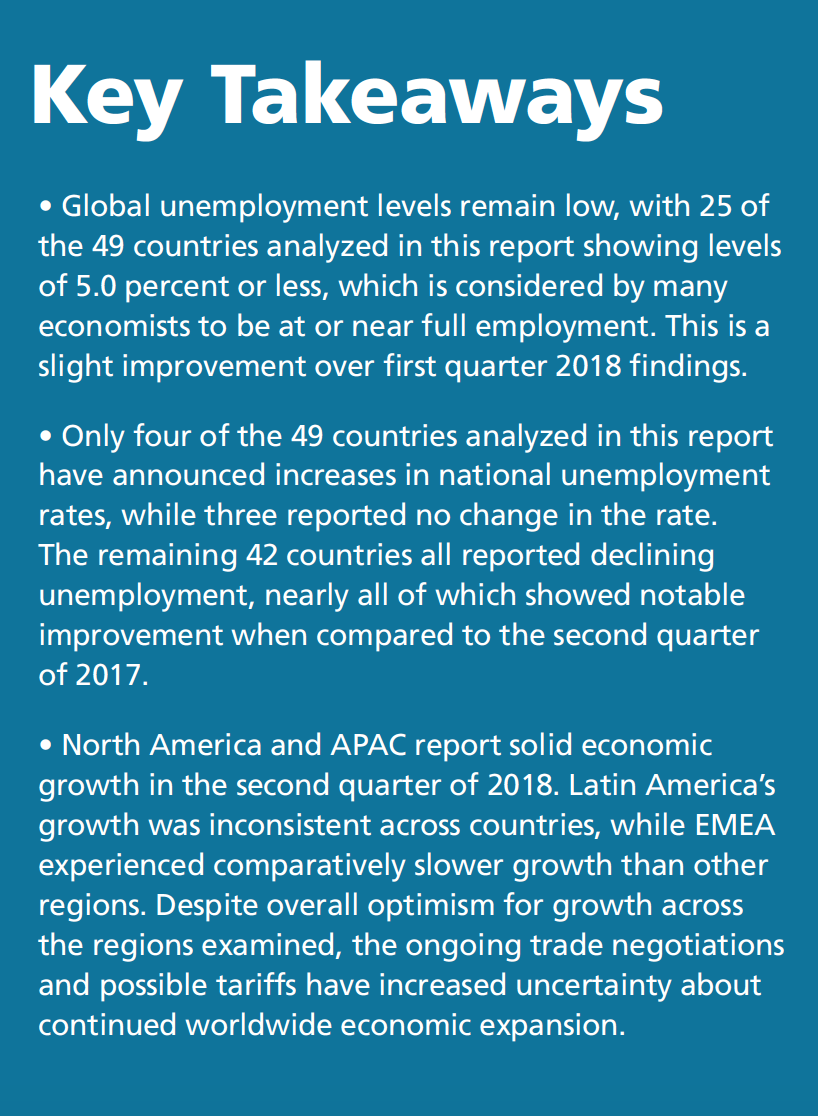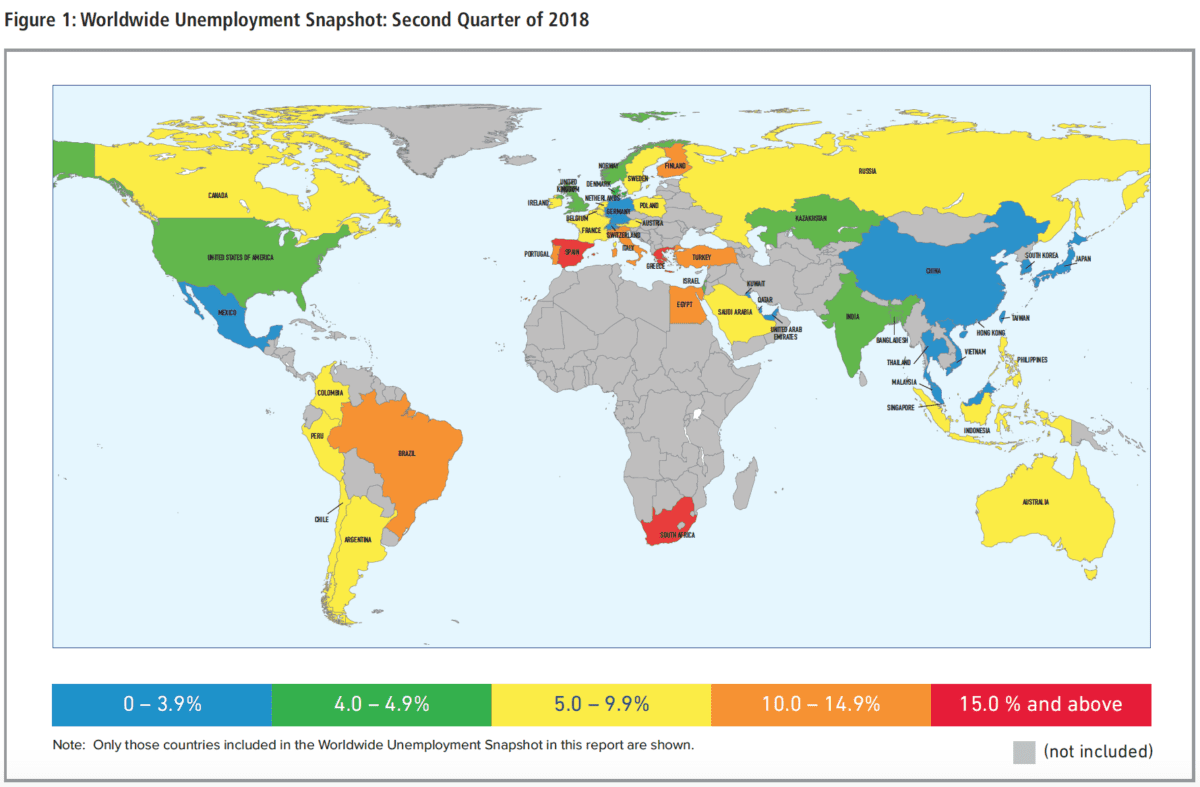North America and APAC continue to show strong economic growth.
By Larry Basinait
Deploying a global workforce and ensuring access to the best talent is a crucial component of success for many enterprises. Global labor market data is an invaluable tool for multinational HR departments and can be used to inform critical decisions around the best countries and regions in which to grow. PeopleScout, a global provider of RPO, MSP, and total workforce solutions, has partnered with HRO Today to produce quarterly reports that compile current international labor market figures, including measures such as national Gross Domestic Product (GDP), unemployment rates, and important trends from the world’s leading economies by country and region. This data reveals actionable information about the quality and availability of the talent pool, working conditions, and recruitment opportunities.
This quarter, economists describe the global economy as experiencing a cyclical recovery, reflecting a rebound in investment, manufacturing activity, and trade. This improvement comes against the backdrop of favorable global financing conditions, generally accommodative policies, rising confidence, and stabilized commodity prices. The improvement in growth has been geographically broad, with growth rates rising in more than half of the world’s economies. Global growth is projected to edge up to 3.1 percent in 2018.
While the fundamentals remain good for the world economy, there is some degree of caution from employers looking forward. As the largest economy, the United States is pursuing a policy of trade re-negotiations that could lead to the imposition of tariffs by the U.S. and against the U.S. Even a small deceleration of trade flows could have negative repercussions on world GDP growth and raise the likelihood of financial stress and defaults. This slowdown could result in higher worldwide unemployment rates.
North America
According to the Bureau of Economic Analysis, real GDP in the U.S. increased by a substantial 4.1 percent in the second quarter of 2018, up considerably from 2.2 percent in the first quarter of 2018. The increase in real GDP in the second quarter reflected positive contributions from personal consumption expenditures (PCE), exports, nonresidential fixed investment, federal government spending, and increased state and local government spending.
In June, the U.S. unemployment rate was 4.0 percent, down slightly from the the end of the first quarter’s mark of 4.1 percent. Unemployment rates at 5.0 percent or just below are considered by many economists to be at or near full employment. Full employment means that unemployment has fallen to the lowest possible level that will not cause inflation.
The Canadian unemployment rate increased slightly by 0.2 percentage points in June to 6.0 percent, which is still near record lows for the country. Canada’s economy appears to have held up reasonably well through the first half of the year, despite the slowdown in Canadian consumer spending in the first quarter. Higher interest rates and new mortgage lending rules continue to affect consumers in the second quarter.
Asia-Pacific (APAC)
 The economies of East and South Asia (ESA) continued to remain robust in the second quarter of 2018. A preliminary GDP growth estimate for the region shows that ESA countries expanded at an aggregated rate of 6.3 percent in the second quarter, very consistent with the reported growth from the prior two quarters.
The economies of East and South Asia (ESA) continued to remain robust in the second quarter of 2018. A preliminary GDP growth estimate for the region shows that ESA countries expanded at an aggregated rate of 6.3 percent in the second quarter, very consistent with the reported growth from the prior two quarters.
Looking forward, however, economic growth in the region is projected to slow. The second quarter’s positive export growth performance in the region was due to the front-loading of production and shipping ahead of the implementation of possible trade tariffs between China and the United States in July. Therefore, the positive export news may not reflect an accurate picture of economic growth.
China has by far the largest economy in the region with a GDP of more than $14 trillion, and is nearly three times larger than the second biggest economy, Japan, which has a GDP of $5.2 trillion. In the second quarter of 2018, unemployment in these top two regional players again decreased from already low rates, with China reporting 3.8 percent unemployment and Japan a remarkable 2.4 percent.
Europe, the Middle East, and Africa (EMEA)
The Eurozone’s slower growth rates than other regions at the start of this year carried over into the region’s second quarter results. In the second quarter of 2018, GDP expanded 0.4 percent over the previous period, below the level of 0.7 percent growth seen throughout most of 2017. The sluggish pace was likely driven by weak exports and subdued domestic demand amid lower confidence, higher inflation, and reduced global trade. However, the growth rate was still at a positive level overall and the economy’s fundamentals remain solid, reflected by an improving labor market.
Unemployment rates in the overall EMEA region declined in 24 of the 27 countries examined in this report, with all of the largest economies posting improved unemployment statistics. In Germany, the largest European economy, unemployment decreased by 0.1 percent to 3.4 percent in the second quarter of 2018. The economy accelerated in the second quarter and is expected to continue growing robustly in the second half of the year.
Latin America
Available data suggests that Latin America’s economic momentum held up in the second quarter, despite political turbulence in key economies and an uncertain economic backdrop. Regional GDP (excluding Venezuela) is expected to have expanded 2.0 percent annually in the second quarter, a notch above the first quarter’s 1.9 percent increase.
Weak economic data continued to plague Brazil in the second quarter. Economic activity showed the largest contraction on record in May, and retail sales plunged in the same month while the manufacturing output fell in June. Economists estimate the economy will grow only 1.7 percent this year, down from prior forecasts. However, despite a poor quarter, unemployment edged down 0.7 percent to 12.4 percent.















